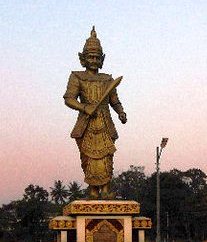Mingyi Nyo facts for kids
Quick facts for kids King Mingyi Nyoမင်းကြီးညို |
|||||
|---|---|---|---|---|---|

Statue of Mingyi Nyo in Taungoo
|
|||||
| King of the Toungoo dynasty | |||||
| Reign | 16 October 1510 – 24 November 1530 | ||||
| Coronation | 11 April 1511 | ||||
| Predecessor | New office | ||||
| Successor | Tabinshwehti | ||||
| Viceroy of Toungoo | |||||
| Reign | c. April 1485 – 16 October 1510 | ||||
| Coronation | 11 November 1491 | ||||
| Predecessor | Min Sithu | ||||
| Successor | Mingyi Swe | ||||
| Born | c. July 1459 Wednesday, 821 ME Ava (Inwa)? |
||||
| Died | 24 November 1530 (aged 71) 5th waxing of Nadaw 892 ME Toungoo (Taungoo) |
||||
| Burial | Toungoo | ||||
| Consort | Soe Min Hteik-Tin Thiri Maha Sanda Dewi Yadana Dewi Maha Dewi Yaza Dewi |
||||
| Issue | Tabinshwehti Atula Thiri |
||||
|
|||||
| House | Toungoo | ||||
| Father | Maha Thinkhaya | ||||
| Mother | Min Hla Nyet | ||||
| Religion | Theravada Buddhism | ||||
Mingyi Nyo (Burmese: မင်းကြီးညို; 1459–1530) was a very important ruler in the history of Burma (Myanmar). He was the founder of the Toungoo dynasty. For 45 years, from 1485 to 1530, he led the region of Toungoo (Taungoo). Under his rule, Toungoo changed from a small, faraway area controlled by the Ava Kingdom into a strong, independent kingdom.
In 1510, Mingyi Nyo officially declared Toungoo's independence. He was very skilled at keeping his small kingdom safe. While other parts of Upper Burma were fighting, Toungoo remained peaceful. Many people from the Ava Kingdom, who were trying to escape wars, came to Toungoo for safety. This made Toungoo even stronger. When Mingyi Nyo died, he left behind a stable and confident kingdom. This allowed his son, Tabinshwehti, to build a much larger empire.
Contents
Early Life and Rise to Power
Mingyi Nyo was born around July 1459. His parents were Maha Thinkhaya and Min Hla Nyet. His family had connections to earlier kings of Bagan and Pinya. He likely grew up in Ava.
Around the age of eleven or twelve, his family moved to Toungoo. This happened when his grandfather, Sithu Kyawhtin, became the leader (viceroy) of Toungoo. When his grandfather died in 1481, Mingyi Nyo's uncle, Min Sithu, became the new viceroy. Around April 1485, Mingyi Nyo took control of Toungoo himself. He then sent gifts to the King of Ava, Minkhaung II, who recognized him as the new governor.
Building a Strong Kingdom (1485–1510)
Mingyi Nyo, now known as Thiri Zeya Thura, worked to strengthen Toungoo. He helped the Ava Kingdom in some of its battles. This was important because it showed his loyalty at first. In 1491, he built a new, strong city called Dwayawaddy near Toungoo. This new city had good defenses.
Mingyi Nyo also tested the power of the larger Hanthawaddy Kingdom to the south. He sent a small raid into their land. Hanthawaddy responded with a large army and navy in 1495. They surrounded Dwayawaddy. Toungoo barely survived this attack. After this, Mingyi Nyo avoided fighting Hanthawaddy for a long time. Even though Mingyi Nyo had caused the conflict, the King of Ava gave him a higher title. This was because Mingyi Nyo was one of the few loyal leaders left.
By the early 1500s, Toungoo had become as powerful as its ruler, Ava. Mingyi Nyo started to show more independence. He welcomed people who had rebelled against the new King of Ava, Shwenankyawshin. In 1502, the Ava king tried to keep Toungoo's loyalty. He gave Mingyi Nyo a valuable region called Kyaukse granary. Mingyi Nyo accepted the land and moved many people from other areas to his capital. However, he did not help Ava against its new enemies. Instead, he joined other rebel groups. By 1509, more areas like Taungdwingyi came under his control.
Declaring Independence (1510–1530)
In 1510, Mingyi Nyo built a new capital city called Ketumati. This is the modern-day Toungoo. It had strong, fortified walls. On October 16, 1510, Mingyi Nyo officially announced that Toungoo was an independent kingdom. At his coronation ceremony on April 11, 1511, he was crowned king.
The Ava Kingdom could not stop Toungoo's independence. They were too busy fighting the Confederation of Shan States in the north. Toungoo had actually been independent in practice since 1501. After declaring independence, Mingyi Nyo mostly stayed out of the wars between Ava and the Shan States. These wars lasted from 1501 to 1527.
When Ava was struggling, Mingyi Nyo moved his forces into former Ava lands like Yamethin and Taungdwingyi in 1523. Ava tried to attack Toungoo in 1525 but failed. Toungoo remained mostly peaceful. When the Shan Confederation finally defeated Ava in 1527, Mingyi Nyo made sure the land between Ava and Toungoo was difficult to cross. This created a safe zone for Toungoo. Many people and officials from Ava fled to Toungoo, making it even stronger.
Mingyi Nyo passed away on November 24, 1530. His son, Tabinshwehti, became the next ruler.
Mingyi Nyo's Lasting Impact
Mingyi Nyo's 45-year rule was a rare time of peace and stability in Upper Burma. Toungoo's location, surrounded by mountains and hills, helped protect it. It was hard for enemies to reach. The stability of his kingdom attracted many people seeking safety. This flow of refugees increased even more after Ava fell.
The larger population and stronger kingdom allowed Mingyi Nyo's son, Tabinshwehti, and his general, Bayinnaung, to plan attacks against bigger kingdoms. The amazing success of Tabinshwehti in defeating Hanthawaddy started with the long, stable rule of Mingyi Nyo.

